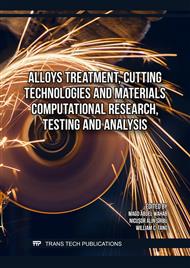[1]
Gupta, S., Omar, T., & Muzzio, F. J. (2022). SEM/EDX and Raman chemical imaging of pharmaceutical tablets: A comparison of tablet surface preparation and analysis methods. International Journal of Pharmaceutics, 611, 121331.
DOI: 10.1016/j.ijpharm.2021.121331
Google Scholar
[2]
Dias, F. J., Fuentes, R., Navarro, P., Weber, B., & Borie, E. (2020). Assessment of the chemical composition in different dental implant types: An analysis through EDX system. Coatings, 10(9), 882.
DOI: 10.3390/coatings10090882
Google Scholar
[3]
Michalak, I., Mironiuk, M., & Marycz, K. (2018). A comprehensive analysis of biosorption of metal ions by macroalgae using ICP-OES, SEM-EDX and FTIR techniques. PLoS One, 13(10).
DOI: 10.1371/journal.pone.0205590
Google Scholar
[4]
Pacella, A., Ballirano, P., & Cametti, G. (2016). Quantitative chemical analysis of erionite fibres using a micro-analytical SEM-EDX method. European Journal of Mineralogy, 28(2), 257-264.
DOI: 10.1127/ejm/2015/0027-2497
Google Scholar
[5]
Zadora, G., & Brożek-Mucha, Z. (2003). SEM–EDX—a useful tool for forensic examinations. Materials chemistry and physics, 81(2-3), 345-348.
DOI: 10.1016/s0254-0584(03)00018-x
Google Scholar
[6]
Stefaniak, E. A., Buczynska, A., Novakovic, V., Kuduk, R., & Van Grieken, R. (2009, April). Determination of chemical composition of individual airborne particles by SEM/EDX and micro-Raman spectrometry: a review. In Journal of Physics: Conference Series (Vol. 162, No. 1, p.012019). IOP Publishing.
DOI: 10.1088/1742-6596/162/1/012019
Google Scholar
[7]
Fay, F., Linossier, I., Langlois, V., Haras, D., & Vallee-Rehel, K. (2005). SEM and EDX analysis: two powerful techniques for the study of antifouling paints. Progress in Organic Coatings, 54(3), 216-223.
DOI: 10.1016/j.porgcoat.2005.05.005
Google Scholar
[8]
Gniadek, M., & Dąbrowska, A. (2019). The marine nano-and microplastics characterisation by SEM-EDX: the potential of the method in comparison with various physical and chemical approaches. Marine Pollution Bulletin, 148, 210-216.
DOI: 10.1016/j.marpolbul.2019.07.067
Google Scholar
[9]
Lu, H., Liu, B., Zhang, Y., Ye, J., & Yan, C. (2014). Comparing analysis of elements sub-cellular distribution in Kandelia obovata between SEM-EDX and chemical extraction. Aquatic botany, 112, 10-15.
DOI: 10.1016/j.aquabot.2013.07.007
Google Scholar
[10]
Nuspl, M., Wegscheider, W., Angeli, J., Posch, W., & Mayr, M. (2004). Qualitative and quantitative determination of micro-inclusions by automated SEM/EDX analysis. Analytical and bioanalytical chemistry, 379, 640-645.
DOI: 10.1007/s00216-004-2528-y
Google Scholar
[11]
Falcone, R., Sommariva, G., & Verità, M. (2006). WDXRF, EPMA and SEM/EDX quantitative chemical analyses of small glass samples. Microchimica Acta, 155, 137-140.
DOI: 10.1007/s00604-006-0531-z
Google Scholar
[12]
Velásquez, P., Leinen, D., Pascual, J., Ramos-Barrado, J. R., Grez, P., Gomez, H., ... & Cordova, R. (2005). A chemical, morphological, and electrochemical (XPS, SEM/EDX, CV, and EIS) analysis of electrochemically modified electrode surfaces of natural chalcopyrite (CuFeS2) and pyrite (FeS2) in alkaline solutions. The Journal of Physical Chemistry B, 109(11), 4977-4988.
DOI: 10.1021/jp048273u
Google Scholar
[13]
Khan, S. R., Sharma, B., Chawla, P. A., & Bhatia, R. (2022). Inductively coupled plasma optical emission spectrometry (ICP-OES): a powerful analytical technique for elemental analysis. Food Analytical Methods, 1-23.
DOI: 10.1007/s12161-021-02148-4
Google Scholar
[14]
Akatsuka, H. (2019). Optical Emission Spectroscopic (OES) analysis for diagnostics of electron density and temperature in non-equilibrium argon plasma based on collisional-radiative model. Advances in Physics: X, 4(1), 1592707.
DOI: 10.1080/23746149.2019.1592707
Google Scholar
[15]
Mackus, A. J. M., Heil, S. B. S., Langereis, E., Knoops, H. C. M., Van de Sanden, M. C. M., & Kessels, W. M. M. (2010). Optical emission spectroscopy as a tool for studying, optimizing, and monitoring plasma-assisted atomic layer deposition processes. Journal of Vacuum Science & Technology A, 28(1), 77-87.
DOI: 10.1116/1.3256227
Google Scholar
[16]
Ghosh, S., Prasanna, V. L., Sowjanya, B., Srivani, P., Alagaraja, M., & Banji, D. (2013). Inductively coupled plasma–optical emission spectroscopy: a review. Asian Journal of Pharmaceutical Analysis, 3(1), 24-33.
Google Scholar
[17]
Xiong, Q., Nikiforov, A. Y., González, M. A., Leys, C., & Lu, X. P. (2012). Characterization of an atmospheric helium plasma jet by relative and absolute optical emission spectroscopy. Plasma Sources Science and Technology, 22(1), 015011.
DOI: 10.1088/0963-0252/22/1/015011
Google Scholar
[18]
Aragón, C., & Aguilera, J. A. (2008). Characterization of laser induced plasmas by optical emission spectroscopy: A review of experiments and methods. Spectrochimica Acta Part B: Atomic Spectroscopy, 63(9), 893-916.
DOI: 10.1016/j.sab.2008.05.010
Google Scholar
[19]
Janis, D., Jönsson, P. G., Appell, A., & Janis, J. (2016). Application of pulse distribution analysis with optical emission spectroscopy (PDA/OES) method during production of duplex stainless steel. Ironmaking & steelmaking, 43(2), 121-129.
DOI: 10.1179/1743281215y.0000000056
Google Scholar
[20]
Donati, G. L., Amais, R. S., & Williams, C. B. (2017). Recent advances in inductively coupled plasma optical emission spectrometry. Journal of Analytical Atomic Spectrometry, 32(7), 1283-1296.
DOI: 10.1039/c7ja00103g
Google Scholar
[21]
Chertok, B., Cole, A. J., David, A. E., & Yang, V. C. (2010). Comparison of electron spin resonance spectroscopy and inductively-coupled plasma optical emission spectroscopy for biodistribution analysis of iron-oxide nanoparticles. Molecular pharmaceutics, 7(2), 375-385.
DOI: 10.1021/mp900161h
Google Scholar


